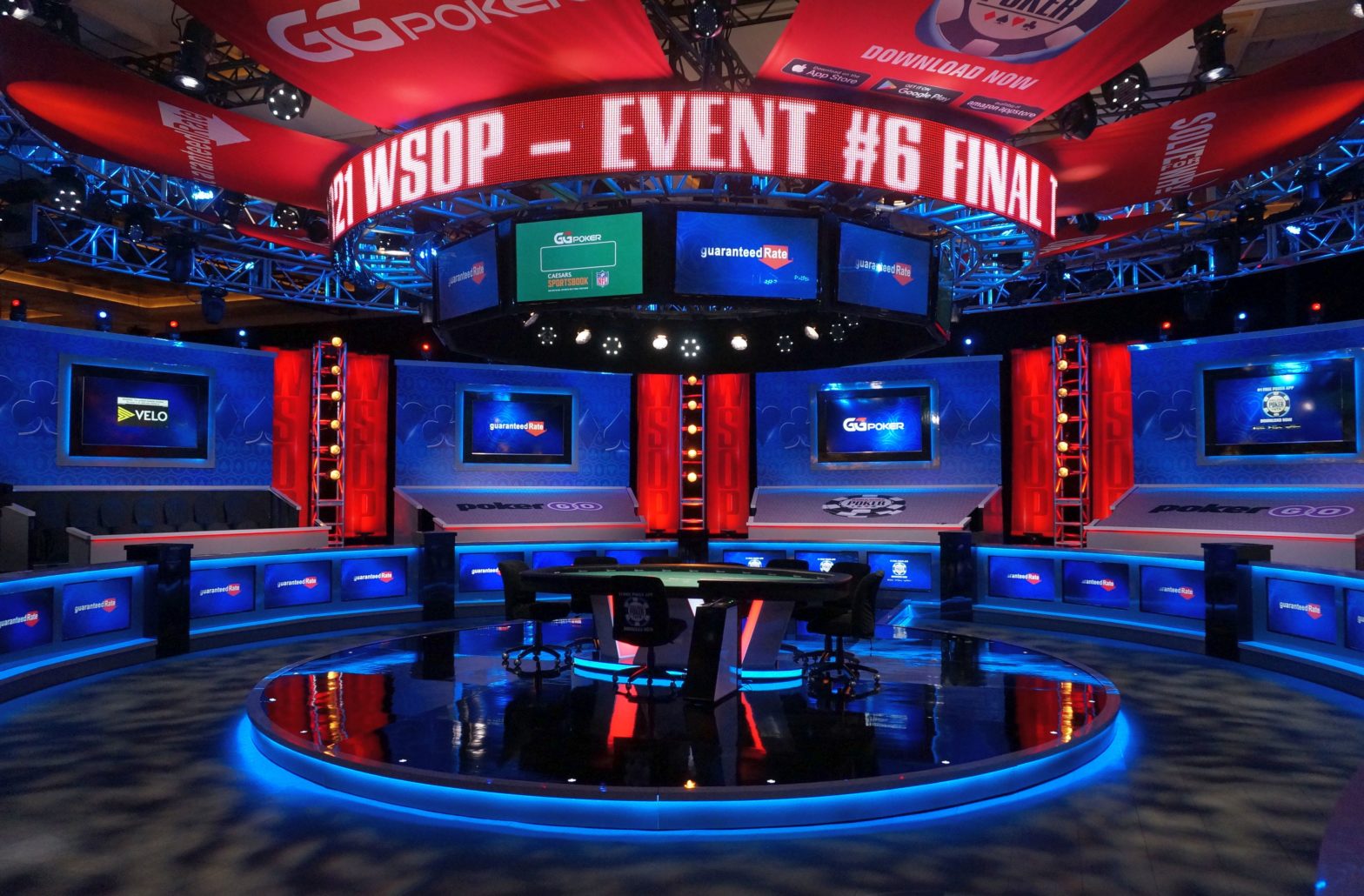The World Series of Poker has always served up its Main Event as its prime course, but in 2023, that went to new heights, literally. More formally known as the $10,000 No-Limit Hold’em World Championship, the event received even more promotional love from the WSOP and its parent company, Caesars Entertainment, than any other WSOP Main Event in history.
The reason for the corporate love was simple enough. The Main Event’s attendance record of 8,773 players had been on display for 17 years, and that’s a long time — likely too long, in Caesars’ corporate view — for something that’s been viewed for more than 40 years as poker’s biggest and most important single event.
After all, it’s hard for the WSOP to present the Main Event and poker in general as growing concerns when its showcase event can’t top an attendance mark set nearly two decades ago, even if all of it is a “That was then, this is now” type of tale.
Promote, promote, promote
So, the WSOP pulled out all the promotional stops it could think of in making the 2023 Main Event a near certainty to wipe the old 2006 mark from the top of the history charts.
Domestically, Caesars ran a “Main Event Maynia” promotional program through just about every Caesars property that had a poker room. Run on several May weekends, the “Maynia” was designed to generate entries from across the country.
Caesars’ and the WSOP’s international partner, GGPoker, was also asked to step up in a big way. In terms of online satellute qualifiers, WSOP.com remains limited by American law, in that Americans can play regulated, online WSOP poker in only a small handful of US states.
So it fell to GGPoker to handle the international-satellite channel, and they ended up sending well over 700 players into the Main Event. That and the Main Event Maynia alone likely generated enough extra participants to assure the old mark would fall, but the WSOP took no chances.
The series added live mega-satellites before and even during the Main Event’s early days, and late-registration remained open after the Main Event’s Day 1A kickoff to an unprecedented level. Not only could players enter during all of the Main Event’s first four opening flights — Days 1A, 1B, 1C, and 1D — but late regesitration extended for a couple of two-hour levels each on Days 2ABC and 2D as well.
Should a player decide to max-late-register, as many players do, they could have entered thr 2023 Main Event more than five calendar days after it began. For a live freezeout event running every day, I believe that’s unprecedented.
So, a fait accompli. The 2006 mark was going to fall, and the only question was by how much. By the dinner break of Day 2D, the answer came in: 10,043 players had taken part in the 2023 Main Event, 1,270 more than the previous record.
Apples and oranges
Caesars and the WSOP had to battle entry-level perceptions, though the truth was that the Main event was a far different beast than what it was back in 2006. That year marked the end of the first true golden era of online poker, when every online site and their second- and third-cousin skin sites ran online qualifiers around the globe to send players to Las Vegas and the Main Event.
The WSOP and Caesars hated how other poker brands profiteered off the WSOP Main Event’s prominence and reputation, though the WSOP and Caesars didn’t hate nearly as much the rake it took in from each and every one of those players.
Back in 2006, you couldn’t spin in a circle without running into branding from one of the WSOP’s direct competitors. Most of the Rio’s Miranda Room, which is an even larger ballroom than the Rio’s more famous Amazon Room, was given over to a massive commercial display, a poker-themed street fair and commercial display.
I don’t recall if that was the first WSOP Pokerpalooza, but whatever it was, it was strange. All the big online sites had a presence in the Miranda Room, and there were more booths and displays in the hallways outside. Several of the largest online sites also had hospitality suites across the hall, as the series was small enough in those days that the actual poker action took place in Amazon and the portion of Miranda not used for the commercial fair.
That the 2006 Main Event got to 8,773 players is both a wonder and a testament to how popular online poker had become in just a few years. I don’t believe the WSOP has ever formally released the numbers on how many Main Event participants qualified online via competitors’ sites, and they mayn not even know. Many sites designated one or more company officials to pay out the seat-and-expenses packages in cash once they met up in Vegas. Sadly, there were even one or two instances of tiny sites who just absconded with the money for the promised seat packages and left their online winners high and dry.
How many of those 8,773 entrants in the 2006 Main came via competitors’ online qualifiers, rather than through the WSOP’s own organic channels? Who knows? Fully half seems like a realistic number.
Up-and-down attendance cycles made 2006 mark hard to top
But it couldn’t last. Later that year, the United States passed and signed into law the Unlawful Internet Gambling Enforcement Act, which crippled the ability of American players to get money onto many offshore sites.
That wasn’t the only UIGEA hurdle. While financial workarounds were available, there was a second legal hitch: The US and the United Kingdom had long had a reciprocity agreement in place, where people accused of committing a crime in or against one of the two countries, while doing so from the other, was then eligible to be extradited to face charges.
Several of the largest online-poker networks were domiciled in the UK, including PartyGaming, whose PartyPoker brand had been the world’s largest. Party pulled out of the US market, in the process ceding the title of “world’s largest online site” to its bitter rival, PokerStars.
Several other companies, mostly UK-based, followed Party’s lead. Between the loss of the online sites and the increased difficulty in funding online-poker accounts, the WSOP and its Main Event took a big, big hit. Attendance dropped more than 25%, from 8,773 to 6,358.
It would be a long road back to 8,773, much longer than anyone realized. The Main Event began rebuilding, and for the next several years, attendance climbed. Then, in 2011, a legal clampdown happened again. In April of 2011, the legendary “Black Friday” wave of indictments were handed down, targeting Full Tilt, PokerStars, and the Cereus Network sites UB.com (formerly UltimateBet and Absolute Poker). Domains were ceased, money was frozen, and only PokerStars would survive the debacle.
Those sites, though, alomg with Bodog, had become the largest unofficial and offshore channels to qualify for the WSOP Main Event. When those channels disappeared, WSOP Main Event attendance took another hit, and another rebuild began.
That’s what the 2010s were for the WSOP Main Event, a long, slow climb back toward those 2006 heights. In 2019, amid much anticipation, the WSOP nearly got there. In the event won by Hossein Ensan, 8,569 players took part, less than 200 from the old 2006 standard.
Surely, 2020 would be the year the 2006 finally fell. Then, in the early months, the COVID-19 pandemic struck. You know the rest of that story. There was a 2020 Main Event, but it was an artificial construct. The 2021 Main Event was still hampered by pandemic concerns, and only in 2022 did the old mark again seem to be in reacch.
And again, in 2022, it was another near miss. Player attendance came in at 8,663, tantalizingly just 110 entries short. Barring a fourth setback from outside influences, that made 2023 the year the old mark would finally fall.
Buh-bye, Jamie
And of course, the 2006 mark disappeared earlier this month, thus removing the Jamie Gold-won 2006 Main Event from the record books. That, though, led to a follow-up curioisity.
Gold was also the recordholder for the single largest WSOP Main Event, when he won $12 million. It may also have been the most controversial winner’s payout in Main Event history. Gold was sponsored into the event by Bodog, for which he had done some promotional work, but in the process of finding some recognizable players that Bodog could also patch up during the event, Gold promised half of his own ME winnings to another man, Bruce Crispin Leyser.
When Gold dominated the late stages of the Main Event and ran away with the title, there was also some confusion and dispute regarding his promises to Leyser. A short time later, Leyser sued Gold, an he eventually settled for a share of the winnings.
How that relates back to the modern-day WSOP Main Event is this: In 2014, the WSOP changed its payout structure for events, rewarding the top 15% of finishers, instead of the top 10% as it had been when Gold won.
That caused an issue for the WSOP as it worked to get the 2006 ME attendance record off the books. Had the WSOP used its standard payout structure for the 2023 Main Event, then even with the attendance record being broken, Gold’s record $12 million payday would likely still remain on top; a winner’s prize somewhere around $11.4 million would have been in line with the current structure.
The WSOP, though, really wanted Gold’s individual payday record to go away as well. Had Gold’s mark remained, it would have raised a lot of questions about why it still stood. Not only would that involve re-explaining the old 10%/15% change, but it also risked bringing up the controversies behind Gold’s win.
So the WSOP jimmied the payout numbers, boosting the prize eventually paid to Daniel Weinman from 11-whatever to a new-record $12.1 million. Doing so required shaving many thousands of dollars from other payout spots, from second place on down. For the first time in many years, the ninth-place finisher, who made the final table, didn’t even get the customary million dollars.
The payout structure was widely dissed by most players, including several who were still in the Main Event. Yet the WSOP and Caesars had its reasons, and they were very corporate reasons indeed.
Anyway, it’s all now part of poker history. The new Main Attendance mark has been set, and Weinman owns the matching mark for the biggest ME payday. That’s how the WSOP wants it to appear going forward, and like a voice from on high, that’s how it’s going to be.

